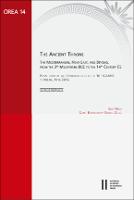Please use this identifier to cite or link to this item:
https://hdl.handle.net/20.500.12202/9887Full metadata record
| DC Field | Value | Language |
|---|---|---|
| dc.contributor.author | Koller, Aaron | - |
| dc.contributor.editor | Gilboa, Dana Brostowsky | - |
| dc.contributor.editor | Nael, Liat | - |
| dc.date.accessioned | 2024-02-29T18:47:54Z | - |
| dc.date.available | 2024-02-29T18:47:54Z | - |
| dc.date.issued | 2020 | - |
| dc.identifier.citation | Koller, A. (2020). Thrones and crowns: On the regalia of the West Semitic Monarchy. In: L. Naeh & D. Brostowsky (Eds.), The throne in art and archaeology from the dawn of the Ancient Near East until the Late Medieval Period, (pp. 123-134). Institute for Oriental and European Archaeology of the Austrian Academy of Sciences. | en_US |
| dc.identifier.isbn | 9783700188025 | - |
| dc.identifier.uri | https://www.academia.edu/44068877/_Thrones_and_Crowns_On_the_Regalia_of_the_West_Semitic_Monarchy_in_The_Ancient_Throne_The_Mediterranean_Near_East_and_Beyond_from_the_3rd_Millennium_BCE_to_the_14th_Century_CE_ed_Liat_Naeh_and_Dana_Brostowsky_Gilboa_Austrian_Academy_of_Sciences_2020_123_134 | en_US |
| dc.identifier.uri | https://ezproxy.yu.edu/login?url=https://search.ebscohost.com/login.aspx?direct=true&AuthType=ip,sso&db=nlebk&AN=3038369&site=eds-live&scope=site&ebv=EB&ppid=pp_123 | en_US |
| dc.identifier.uri | https://hdl.handle.net/20.500.12202/9887 | - |
| dc.description | Scholarly book chapter | en_US |
| dc.description.abstract | Abstract: Whereas the crown was a central icon of kingship in ancient Mesopotamia, West Semitic conceptions of kingship differed deeply from their Mesopotamian counterparts. In Iron Age Levantine cultures (including Aramean, Phoenician, and Israelite), the throne was a far more potent symbol of the monarchy than was the crown, as is reflected in the iconography, and especially in texts. Phoenician and Aramaic royal inscriptions, as well as biblical texts, show that the preeminent regalia of royalty in the region were not crowns, but thrones and “shoots,” or scepters. This paper draws on epigraphic, visual, and literary materials from the Levant, as well as comparative evidence not only from Mesopotamia, but also from Egypt and the Hittite world to emphasize the significance of the image of the throne in constructing the image of the monarch in the Levant. Keywords: royal inscriptions; Levant; kingship; thrones; Hebrew Bible The goal of this paper is to draw attention to a difference between West Semitic and East Semit- ic depictions of the trappings of kingship. In brief, while Mesopotamian, Egyptian, Hittite and Persian sources speak of the crown as emblematic of the king, Levantine texts of the 2nd and 1 st millennia BCE speak primarily of the throne and the ‘staff,’ which will be seen to be a flowering stick. Although the visual depictions of kings complicate this neat dichotomy, we will see that in texts from the Levant, including the Bible, the staff was a powerful symbol representing power and authority, primarily, though not exclusively, royal. Let us begin with some of the textual evidence from Old Aramaic inscriptions.2 The royal ‘authors’ of these texts often made reference to their ascension to the kingship, and the ways in which this is described can be valuable evidence. Some of the references are neutral in this regard; Zakkur, for example, states simply, (l. 3), 3 and Hazael reports, (Tel Dan 4). But some of the other Aramean kings use a more interesting locution. In the inscrip- tion that Bar-Rakib, king of Sam’āl (Zincirli), wrote memorializing his father, Panamuwa II, in c. 730 BCE, he reports, And I, Bar-Rakib b. Panamuwa, Because of the loyalty of my father and my own loyalty, My lord Tiglath-Pileser, king of Assyria seated me On the seat of my father, Panamuwa b. Bar-ṣur (KAI I. 215, lines 19–20).4 In Bar-Rakib’s own slightly later inscription, he proudly says, 1 Yeshiva University, New York, USA; koller@yu.edu. 2 It should be stated out the outset that this paper was written by a philologist, who has worked, with the guidance | en_US |
| dc.language.iso | en_US | en_US |
| dc.publisher | Austrian Academiy of Sciences ; Verlag der österreichischen Akademie der Wissenschaften, 2020. | en_US |
| dc.relation.ispartofseries | Bernard Revel Graduate School: Faculty Publications;2020 | - |
| dc.rights | Attribution-NonCommercial-NoDerivs 3.0 United States | * |
| dc.rights.uri | http://creativecommons.org/licenses/by-nc-nd/3.0/us/ | * |
| dc.subject | Thrones --History --To 1500 --Congresses | en_US |
| dc.subject | Throne in art --Congresses | en_US |
| dc.subject | Middle East --Civilization --Congresses | en_US |
| dc.subject | Oriental and European archaeology | en_US |
| dc.subject | royal inscriptions | en_US |
| dc.subject | Levant | en_US |
| dc.subject | Kingship | en_US |
| dc.subject | thrones | en_US |
| dc.subject | Hebrew bible | en_US |
| dc.title | Thrones and crowns: On the regalia of the West Semitic Monarchy. | en_US |
| dc.title.alternative | Oriental and European Archaeology ; Vol. 14 | en_US |
| dc.type | Book chapter | en_US |
| dc.contributor.orcid | 0009-0001-4065-6747 | en_US |
| local.yu.facultypage | https://www.yu.edu/faculty/pages/koller-aaron | en_US |
| Appears in Collections: | Bernard Revel Graduate School of Jewish Studies (BRGS): Faculty Publications | |
Files in This Item:
| File | Description | Size | Format | |
|---|---|---|---|---|
| Koller 2020 OA Thrones_and_Crowns_On_the_Regalia_.pdf | 3.35 MB | Adobe PDF |  View/Open |
This item is licensed under a Creative Commons License

